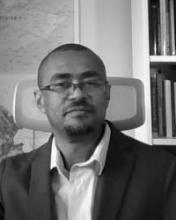By Kathryn Medill and Mehari Worku
The MELC Department already offers opportunities for students to learn about ancient and modern Middle Eastern cultures and their diasporas around the world. Now we have expanded to include the Horn of Africa, an area which has always been deeply connected with the Middle East. The Horn of Africa includes the modern countries of Ethiopia, Eritrea, Djibouti, and Somalia.
Mehari Worku is our new full-time hire in Horn of Africa Studies. He will be teaching both language and content courses relevant to this region. We asked him a few questions about the Horn of Africa and the new program!
Why is the Horn of Africa important?
The Horn of Africa (HOA) is a crucial region in the political economy of Africa, Europe, and Asia. Positioned on the western side of the Red Sea, it lies along one of the world’s major trade routes. The HOA has historically been a melting pot of diverse peoples from Africa, Europe, and Asia, contributing to its unique and vibrant human history.
This region is recognized as one of the earliest homes of humanity, with archaeological evidence suggesting that human beings first lived here before migrating elsewhere. For those interested in archaeology, the HOA is a gold mine of discoveries. Its rich history of state formation and literary traditions also make it an invaluable resource for scholars of history and literature. The region's ethnolinguistic diversity is equally compelling, attracting many anthropologists and linguists eager to study its unique cultures and languages.
Religiously, the HOA is characterized by profound diversity. For centuries, it has been a home to Judaism, Christianity, and Islam, each of which has developed distinct local expressions. The interaction between these major world religions and indigenous belief systems has created a richly unique religious and cultural milieu that continues to fascinate scholars.
What courses are you offering this year?
I am offering language courses Amharic I, II and III (AMHAR 101, 102, 103, with the sequence starting in Fall 2024); as well as content courses like “The Virgin Mary in Ethiopic Christianity” (MELC 286B, Winter 2025) and “Holy People and Holy Places in the Horn of Africa” (MELC 415, Spring 2025). During the summer I will offer Introduction to Ethiopic Judaism and Christianity (MELC 366).
Are there other courses which you are hoping to offer in the future?
Yes, I am looking forward to giving courses on “Ethiopian Medieval Religious Thought” and Ge’ez language and literature.
What languages are spoken in the Horn of Africa?
According to the latest official data from local governments, there are about 95 different ethnolinguistic groups in the Horn of Africa. Some languages, such as Oromo, Somali, Sidama, Wolaita, and Tigrinya, have millions of speakers. These languages play an important role in the local political economy of the respective regions where each ethnolinguistic group has numerical dominance. Most people know multiple languages, regardless of which ethnolinguistic groups they identify with. This multilingualism has proven vital in preserving the region's linguistic diversity and enhancing the economic mobility of its residents. However, because multilingualism can also present challenges, Amharic has become the lingua franca (shared language) for most of the inhabitants of the Horn of Africa.
Additionally, languages like Arabic and English are commonly used in international communications.
What makes Amharic a good language to learn?
It is the most important language in the political economy, history, literature and cultural studies of the Horn of Africa. Since it is the shared language of the region, the more Amharic you know, the more the HOA will open up for you. It is also one of the few languages in the world that has its own unique writing system!
What is a text or piece of art from the Horn of Africa that you would really like to teach? Tell us about it!
There are too many! But two of the texts I am looking forward to sharing with our students in the upcoming quarter are “Nägärä Maryam” and “The Miracles of Mary.” These are religious texts from Medieval Ethiopia. In these texts, Biblical figures like Mary, Joseph and Jesus are presented in an extremely different light than what we see in the Bible or the mainstream Christian discourse. For instance, there is a story about a man who still went to heaven after devouring 78 people because he was able to win Mary’s favor. There is also another story where a few dozen dogs are given the Heavenly Crown of Martyrs because they were more favorable to God than human beings were.
